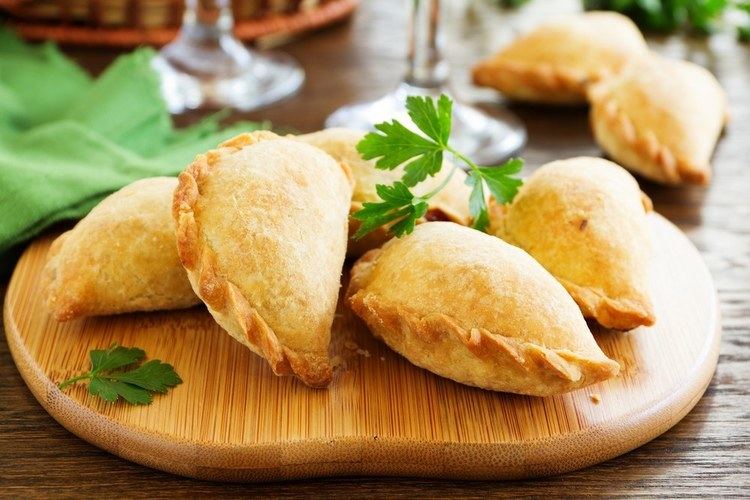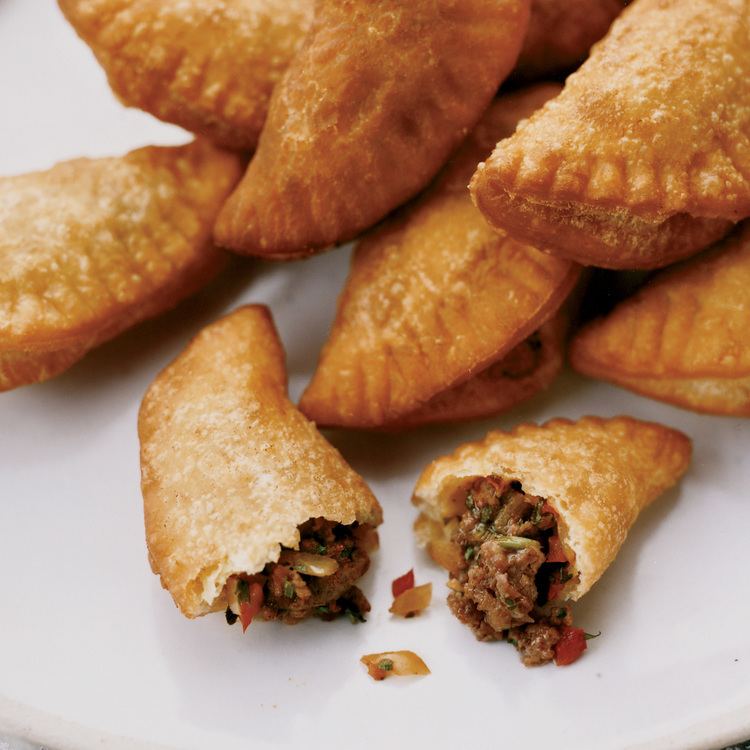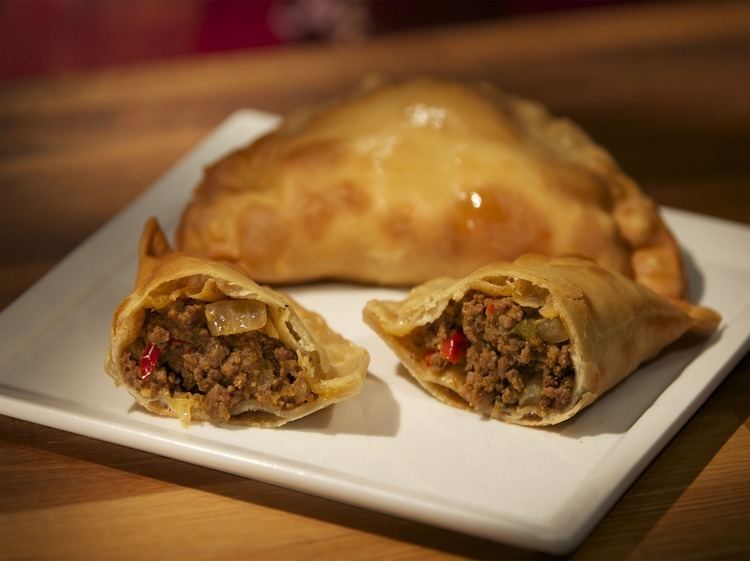Course Appetizer Region or state Latin America, Europe Serving temperature Hot or cold | ||
 | ||
Similar Stuffing, Arepa, Asado, Tamale, Enchilada | ||
Chicken empanada
An empanada ([empaˈnaða]) is a stuffed bread or pastry baked or fried in many countries of Latin America and in Spain. The name comes from the Spanish verb empanar, meaning to wrap or coat in bread.
Contents
- Chicken empanada
- Origins
- Argentina
- Belize
- Cape Verde
- Chile
- Colombia
- India
- Indonesia
- Marianas Islands
- Mallorca Spain
- Philippines
- Sardinia Italy
- Sicily Italy
- United States
- Venezuela
- Similar dishes
- References

Empanadas are made by folding dough over a stuffing, which may consist of meat, cheese, huitlacoche, or other ingredients.

Origins

Empanadas trace back their origins to the northwest region of Spain, Galicia. A cookbook published in Catalan in 1520, Libre del Coch by Robert de Nola, mentions empanadas filled with seafood in the recipes for Catalan, Italian, French, and Arabian food.

Some sources claim a connection with the Indian cuisine. A similar dish first appeared in Portugal around the time of the establishment of trade routes to India and the establishment of a colony at Goa. This is believed to have been derived from or influenced by the Indian Gujia or Samosa, known in Lisbon as the Chamuça da Goa.
Argentina
Argentine empanadas are often served during parties and festivals as a starter or main course. Shops specialize in freshly made empanadas, with many flavors and fillings.
The dough is made with wheat flour and beef drippings for the fillings which differs from province to province. Some places use chicken, and some places beef (cubed or ground depending on the region) spiced with cumin and paprika. Some other fillings are onion, boiled egg, olives, or raisins. Empanadas can be baked (Salta-style) or fried (Tucuman-style). It also can contain ham, fish, humita (sweetcorn with white sauce), or spinach; a fruit filling is used to create a dessert empanada. For the interior regions, they can be spiced with peppers.
In those places (usually take-out shops) where several types are served, a repulgue, or pattern, is added to the pastry fold to distinguish the varieties (although it is more common nowadays to burn a letter – an abbreviated indication of the filling – into the dough). In larger cities, empanadas are eaten more as take-away food, sourced from restaurants specializing in this dish. They usually carry dozens of different varieties, which is not the case in northern provinces, where empanadas are usually made at home, with more traditional recipes.
During Lent and Easter, empanadas de Cuaresma fillings with fish (usually dogfish or tuna) are popular.
Also popular are the so-called "Arabian" empanadas (empanadas árabes or fatay), filled with beef, tomato, onion, and lemon juice, similar to the fatayer made in the Levant.
Belize
In Belize, empanadas are known as panades. They are made with masa (corn dough) and typically stuffed with fish, chicken, or beans. They are usually deep fried and served with a cabbage or salsa topping. Panades are frequently sold as street food.
Cape Verde
Cape Verde cuisine features the pastel, as well. Cape Verdean pastéis are often filled with spicy tuna fish. One particular variety, the pastel com o diabo dentro (literally: Pastel with the devil within), is particularly spicy, and is made with a dough made from sweet potatoes and cornmeal.
Chile
In Chile, the most traditional empanada filling is called "pino". Pino is a seasoned mixture of ground beef, onions, raisins, black olives, and hard boiled eggs. The empananda dough is quick and easy to make, and can be made ahead and stored in the refrigerator. The pino tastes best if made the day before and allowed to rest overnight before filling the empanandas.
The empanada is considered the most symbolic food of the country. Salvador Allende, the President of Chile from 1970 to 1973, emphasized the national character of his political project saying that it would be a “revolution with the flavor of red wine, and the scent of an empanada”.
Chilean empanadas are prepared with different fillings, but the dough is generally made from flour. The most popular versions are called “de pino” (a Chilean word to describe the mix of ground meat and onion) and “de mariscos” (seafood).
Eating empanadas, especially the meat ones called “pino”, becomes more popular during September, the month that Chile celebrates “las fiestas patrias” or their independence. They are eaten during meals like “asados” or Chilean barbeques, and are accompanied with drinks like “la chicha” and red wine.
The meat empanadas called “pino” are filled with ground beef, fried with white onion and are seasoned with garlic, hard-boiled eggs, olives, and sometimes raisins. This version is known as the typical baked Chilean empanada, although it can also be fried. A different variation is called “pequén” it does not contain the “pino” meat, but it does have its same juice. It is filled with lots of white onion and hot chili pepper and is smoldered.[File:///C:/Users/Jill/Desktop/Jenna_Junior_Year/Spanish/wikipedia_-empanadas.docx#_edn6 [vi]] In a city called Pomaire they are known for their big empanadas. They weigh half a kilogram (500 grams), and they also come filled with chicken. They are baked in a clay oven.
Seafood empanadas are filled with crab, clams, sea snails, or special oysters called crassostrea and cheese. Different seafood can be used, and they are mixed with chopped white onion. Generally they are fried in oil, but they can also be baked. They are usually served with white wine and are very popular during “Semana Santa” (the “Holy Week” or the week surrounding Easter).
There are many other kinds of empanadas; vegetable (generally chard), cheese, chicken, “napolitanas”. (cheese, ham, tomato sauce, and oregano), fish (mackerel, galaxias, or salmon), and cochayuyo. There are also empanadas filled with fruit that are made of apples or pears.
Colombia
Colombian empanadas are made with maize meal (same as arepas) and filled with potatoes and meat which are previously stir-fried with spring onion, tomatoes, garlic and cumin. Empanadas are usually fried, but can be prepared in oven. Empanadas are accompanied by different preparations of chili sauces including encurtido (mix of various onions, tomato, fresh coriander, vineger and lime), peanut chili sauce, or chili sauce. Empanadas are consumed like snacks between breakfast and lunch or between lunch and dinner.
India
In Indian cuisine, there are many varieties of empanadas—mostly with sweet fillings. In North India (Uttar Pradesh, Madhya Pradesh and Rajasthan), they are called gujias. Gujias are sweet and are made typically at festival time—especially Holi. They are made with a filling of dry fruits, khoya, etc. In South India they are called Karjikayi or Kajjikaya (Telugu).
In Tamil nadu and Puducherry/Pondicherry they are called somasam or Somas they are usually stuffed with dry filling made of coconut , roasted bengal gram(pottu kadalai)or rava, cashew nuts and sugar. Somasam is one of the main diwali sweet. Somasam recipe . The fillings are usually dry so that the sweet can be stored for weeks.
In Maharashtra they are made during the Ganapati festival and also for Diwali—they are called Karanjis. In Gujarat they are called Ghugra.
In Goa, In Goa, Hindu families prepare Nevriyos are made specially for Ganeshotsav, they of two types of stuffings one with Puran of Bengal gram, Jagerry and Elaichi. It is also called panch khadi mostly it made by Gaud Saraswat Community i.e if in five different forms Nevri,Modak, karmal , Bimbal& puri. Second type is made out of dry desiccated coconut, khus khus, Sugar elaichi cashew nuts. covered with dough of Maida and Rava which makes Nevri Crispy
Catholics make two variants: one for Christmas with a coconut, jaggery and dry fruit filling called Neories/ Nevries, and patties (pattisam) made all year round with beef and/or certain vegetables.
Indonesia
In Indonesian cuisine, a panada is a bread snack filled with spicy tuna or cakalang fish (skipjack tuna). It is derived from the Portuguese empanada. It is the specialty of Manado city, Minahasa people, North Sulawesi, Indonesia.
Marianas Islands
The Chamorro people of Guam and Saipan make an empanada filled with ground, toasted rice, red chili, black pepper, garlic, and annatto. The pastry is made from masa harina and is deep fried.
Mallorca (Spain)
In the Balearic Islands there are panades (Mallorca) and formatjades (Menorca), filled usually with meat or vegetables, or the two things at once. When formatjades are filled with cheese are called 'flaons'. In Mallorca are made cocarrois stuffed with chard, cauliflower, spinach, almonds, raisins, pine nuts or onion. A smaller version is also made. It consists of a small round wafer folded in half, with sweet fillings or salted, fried or baked. In the sixteenth century, like those made with the bread dough, they were called "English empanadas".
Philippines
Filipino empanadas usually contain ground beef, pork or chicken, potatoes, chopped onions, and raisins (somewhat similar to the Cuban picadillo) in a somewhat sweet, wheat flour bread. There are two kinds available: the baked sort and the flaky fried type. To lower costs, potatoes are often added as an extender, while another filling is kutsay, or garlic chives (kutsay in Cebuano and Tagalog; 韭菜 kú-chhài in Lan-nang).
Another traditional Filipino empanada which is currently experiencing a revival is the empanada de calisquis, which has a very flaky, crust somewhat similar to flaky pastry, but has a crunchier mouth-feel due to it being deep-fried. Calisquis (kaliskis) translates to (fish) scales, as the flakes of the crust resemble scales coming off.
Empanadas in the northern part of the Ilocos are different. These usually have savoury fillings of green papaya, mung beans, and sometimes chopped Ilocano sausage (chorizo) and egg yolk. Rather than the soft, sweet dough favoured in the Tagalog region, the dough used to enclose the filling is thin and crisp, mostly because Ilocano empanadas use rice flour coloured orange with achuete (annatto), and is deep-fried rather than baked.
Sardinia (Italy)
In Sardinia, a panada is a pie filled with lamb, potatoes, sundried tomatoes, onions, garlic, saffron, etc.
Sicily (Italy)
The 'Mpanatigghi are stuffed, consisting of halfmoon-shaped panzarotti filled with a mixture of almonds, walnuts, chocolate, sugar, cinnamon, cloves and minced beef. These are typical of Modica, in the province of Ragusa, Sicily. They are also known as impanatiglie or dolce di carne ("pastry of meat").
They were probably introduced by the Spaniards during their rule in Sicily which took place in the sixteenth century; this is suggested from the etymology of the name which comes from the Spanish "empanadas or empadillas" (empanada), as well as from the somewhat unusual combination of meat and chocolate, which occurs several times in the Spanish culinary. In past centuries for the preparation of 'mpanatigghi game meat was used but today beef is used.
United States
Empanadas, mainly based on South American recipes, are widely available in New York City from food carts, trucks, and restaurants.
Empanadas are usually found in U.S. areas with a heavier Hispanic population, like San Antonio, Texas and Los Angeles, California
Venezuela
Venezuelan empanadas differ from other countries' (such as Argentina and Chile) in that they are made with corn flour instead of wheat flour. Venezuelan empanadas, akin to empanadas in other countries in the Caribbean, are generally fried instead of baked. The dough for Venezuelan empanadas is made similarly to the arepa dough, using corn flour, water and salt. In some cases the flour can be flavored with any desired ingredient, such as sugar cane, anise, annatto or just broth.
Similar dishes
Many other world cuisines have dishes very similar to the empanada. These include:
